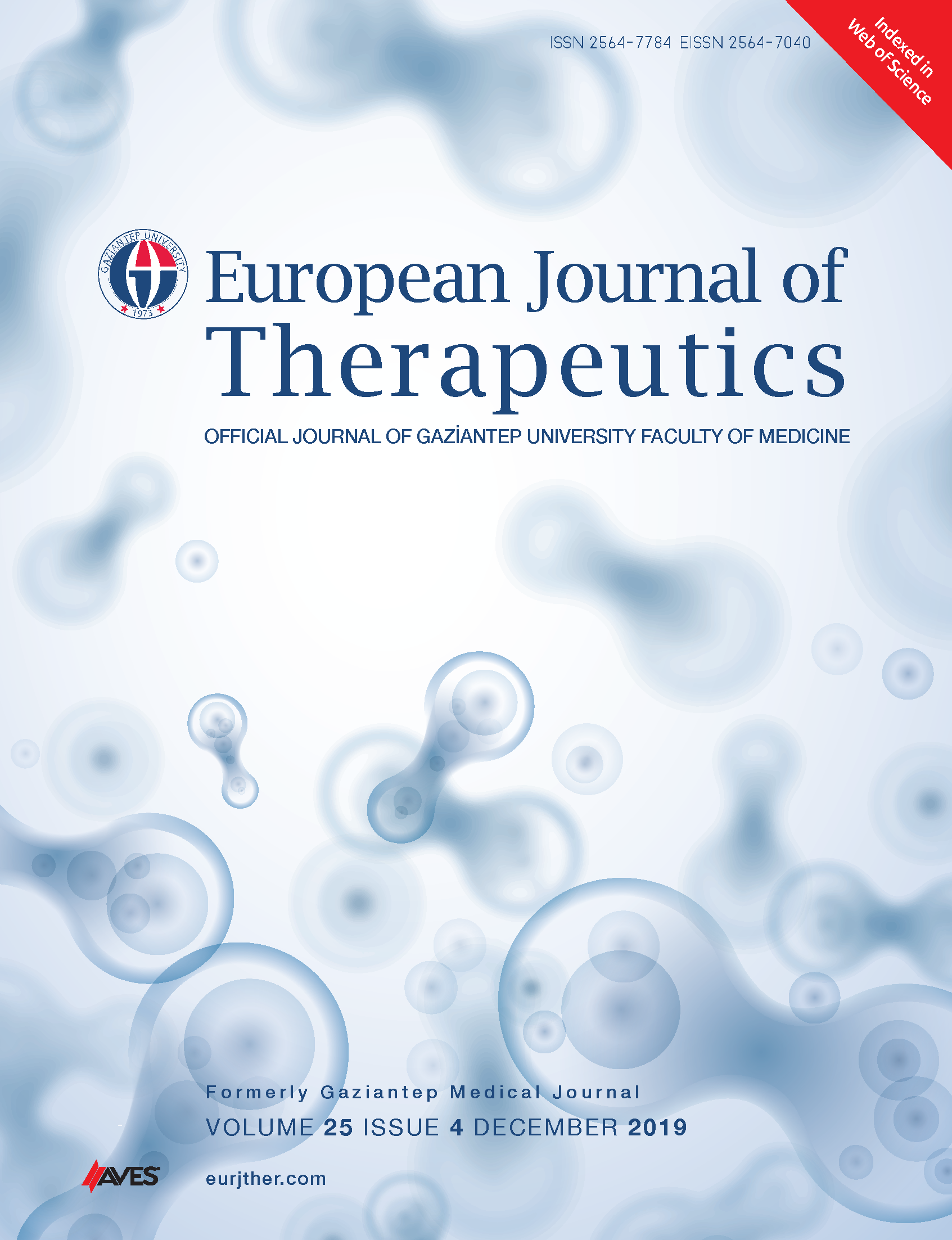Comparison of Pulmonary Artery Catheter and Central Venous Catheter for Early Goal Directed Targeted Therapy in Sepsis and Septic Shock
DOI:
https://doi.org/10.5152/EurJTher.2019.18020Keywords:
Early goal directed therapy, sepsis, septic shockAbstract
Objective: The aim of the present study was to compare the effect of the pulmonary artery catheterization (PAC) method and the central venous catheterization (CVC) method on hemodynamic and inflammatory parameters in early goal-directed therapy (EGDT).
Methods: This was a randomized prospective study. Patients with sepsis and septic shock within 12 h of diagnosis were included in the study. Each group received strict protocolized resuscitation for 72 h.
Results: The mean age of the patients was 63.4±14.5 years. The study included 15 (52%) male and 14 (48%) female patients. The length of stay in the hospital and the duration of mechanical ventilation were similar between the two groups. The length of stay in the intensive care unit was shorter in the CVC group (p=0.025). High mobility group box 1 levels were lower at 72 h in the CVC group (p=0.026). In the early resuscitation period, it was found that in the CVC-directed therapy group, the urine output and the mean arterial blood pressure were higher, but vasoconstrictor need was lower (p<0.05).
Conclusion: In the early resuscitation period, CVC-directed therapy is more effective, and rapid correction of hemodynamic parameters results in shorter intensive care unit stay. PAC is not superior to CVC-guided therapy in the late period.
Metrics
References
Angus DC, Linde-Zwirble WT, Lidicker J, Clermont G, Carcillo J, Pinsky MR. Epidemiology of severe sepsis in the United States. Analysis of incidence, outcome, and associated costs of care. Crit Care Med 2001; 29: 1303-10.
El-Samalouti VT, Hamann L, Flad HD, Ulmer AJ. The biology of endotoxin. Methods Mol Biol 2000; 145: 287-309.
Nguyen HB, Corbett SW, Steele R, Banta J, Clark RT, Hayes SR, et al. Implementation of a bundle of quality indicators for the early management of severe sepsis and septic shock is associated with decreased mortality. Crit Care Med 2007; 35: 1105-12.
Rady MY, Rivers EP, Nowak RM. Resuscitation of the critically ill in the ED. Responses of blood pressure, heart rate, shock index, central venous oxygen saturation, and lactate. Am J Emerg Med 1996; 14: 218-25.
Cortez A, Zito J, Lucas CE, Gerrick SJ. Mechanism of inappropriate polyuria in septic patients. Arch Surg 1977; 112: 471-6.
Beal AL, Cerra FB. Multiple organ failure syndrome in the 1990s. Systemic inflammatory response and organ dysfunction. JAMA 1994; 271: 226-33.
Rajaram SS, Desai NK, Kalra A, Gajera M, Cavanaugh SK, Brampton W, et al. Pulmonary artery catheters for adult patients in intensive care. Cochrane Database Syst Rev 2013; 2: CD003408.
Seymour CW, Rosengart MR. Septic shock: Advances in diagnosis and treatment. JAMA 2015; 314: 708-17.
Yealy DM, Kellum JA, Huang DT, Barnato AE, Weissfeld LA, Pike F, et al. A randomized trial of protocol-based care for early septic shock. N Engl J Med 2014; 370: 1683-93.
Mouncey PR, Osborn TM, Power GS, Harrison DA, Sadique MZ, Grieve RD, et al. Trial of early goal-directed resuscitation for septic shock. N Engl J Med 2015; 372: 1301-11.
Peake SL, Delaney A, Bailey M, Bellomo R, Cameron PA, Cooper DJ, et al. Goal-directed resuscitation for patients with early septic shock. N Engl J Med 2014; 371: 1496-506.
Dellinger RP, Levy MM, Carlet JM, Bion J, Parker MM, Jaeschke R, et al. Surviving Sepsis Campaign: international guidelines for management of severe sepsis and septic shock: 2008. Crit Care Med 2008; 36: 296-327.
Rivers E, Nguyen B, Havstad S, Ressler J, Muzzin A, Knoblich B, et al. Early goal-directed therapy in the treatment of severe sepsis and septic shock. N Engl J Med 2001;345:1368-77.
Boyd O, Grounds RM, Bennett ED. A randomized clinical trial of the effect of deliberate perioperative increase of oxygen delivery on mortality in high-risk surgical patients. JAMA 1993;270:2699-707.
Pinsky MR, Vincent JL. Let us use the pulmonary artery catheter correctly and only when we need it. Crit Care Med 2005;33:1119-22.
Harvey S, Harrison DA, Singer M, Ashcroft J, Jones CM, Elbourne D, et al. Assessment of the clinical effectiveness of pulmonary artery catheters in management of patients in intensive care (PAC-Man): a randomised controlled trial. Lancet 2005; 366: 472-7.
Connors AF, McCaffree DR, Gray BA. Evaluation of right-heart catheterization in the critically ill patient without acute myocardial infarction. N Engl J Med 1983; 308: 263-7.
Connors AF, Speroff T, Dawson NV, Thomas C, Harrell FE, Wagner D, et al. The effectiveness of right heart catheterization in the initial care of critically ill patients. SUPPORT Investigators. JAMA 1996; 276: 889-97.
Sandham JD, Hull RD, Brant RF, Knox L, Pineo GF, Doig CJ, et al. A randomized, controlled trial of the use of pulmonary-artery catheters in high-risk surgical patients. N Eng J Med 2003; 348: 5-14.
Richard C, Warszawski J, Anguel N, Deye N, Combes A, Barnoud D, et al. Early use of the pulmonary artery catheter and outcomes in patients with shock and acute respiratory distress syndrome: a randomized controlled trial. JAMA 2003; 290: 2713-20.
Sandham JD, Hull RD, Brant RF, Knox L, Pineo GF, Doig CJ, et al. A randomized, controlled trial of the use of pulmonary-artery catheters in high-risk surgical patients. N Engl J Med 2003; 348: 5-14.
Esper AM, Moss M, Martin GS. The effect of diabetes mellitus on organ dysfunction with sepsis: an epidemiological study. Crit Care 2009; 13: R18.
Andersson U, Tracey KJ. HMGB1 in sepsis. Scand J Infect Dis 2003; 35: 577-84.
Cohen J, Vincent JL, Adhikari NK, Machado FR, Angus DC, Calandra T, et al. Sepsis: a roadmap for future research. Lancet Infect Dis 2015; 15: 581-614.
Downloads
Published
How to Cite
Issue
Section
License
Copyright (c) 2023 European Journal of Therapeutics

This work is licensed under a Creative Commons Attribution-NonCommercial 4.0 International License.
The content of this journal is licensed under a Creative Commons Attribution-NonCommercial 4.0 International License.


















